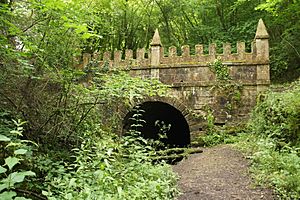Charles Jones (engineer) facts for kids
Quick facts for kids
Charles Jones
|
|
|---|---|
| Citizenship | English |
| Children | At least 3 sons |
| Engineering career | |
| Discipline | Civil engineering |
| Employer(s) | Thames and Severn Canal Company, Basingstoke Canal Company |
| Projects | Sapperton Tunnel, Greywell Tunnel |
Charles Jones was an English civil engineer who lived and worked between 1773 and 1796. He mostly built canal tunnels. He worked with famous engineers like John Rennie and William Jessop. Jones worked on many waterways, but he sometimes struggled to finish projects. He was removed from some jobs because of this.
Contents
Building Canals and Tunnels
Jones knew a lot about masonry (working with stone) and mining. He probably learned these skills in the coalfields of Shropshire or Gloucestershire.
In 1773, he lived in Preston on the Hill. From there, he took on several jobs for the Bridgwater Canal. Later, he worked on the Preston Brook tunnel for the Trent and Mersey Canal. He also helped build the Chesterfield Canal. Jones earned £3 for every yard he dug on the Norwood Tunnel for the Chesterfield Canal.
The Sapperton Tunnel Project

In 1783, the Thames and Severn Canal Company hired Jones. His job was to dig the Sapperton Tunnel. He was paid 7 guineas for each yard. The tunnel was planned to be the longest in the country, at about 3,817 yards (3,490 meters). It was supposed to be finished by 1788.
The canal's engineer, Josiah Clowes, suggested Jones for the job. Clowes said Jones was "well qualified by experience" to manage the work. Jones's budget allowed him to use an early type of railway to help with construction. However, he sometimes had trouble managing his money. He didn't always pay his workers on time and spent some time in places where people who owed money were held. After each time, Jones went back to work on the tunnel.
One time, he almost broke his contract. The contract said he couldn't be away from the tunnel for more than 28 days. He was released on the 27th day. When he returned, the canal company had taken some of his belongings as security. In response, Jones's son, George, caused trouble for the canal company's owner. Because of this, George was not allowed to come within 20 miles (32 km) of the canal for five years.
In 1785, Jones promised not to visit inns near the tunnel. Later that year, Jones disappeared for three days. The canal owners gave him three months to finish the tunnel or quit. Jones was likely dismissed in the summer of 1785. He had dug less than half of the tunnel, about 1,487 yards (1,360 meters). He had opened one entrance at the Daneway end and dug several access shafts. Parts of the tunnel and one entrance collapsed while he was working.
In 1788, Jones took the canal company to court. He claimed he had finished his contract. The company disagreed. They said he owed them money and that he was not a skilled worker. The court case against the canal company was dismissed in 1795.
Other Tunnel Projects
In late 1788, William Jessop hired Jones to dig the Greywell Tunnel for the Basingstoke Canal. Jones called himself the "Architect of Grewell." But his work on this tunnel was similar to his work on the Sapperton Tunnel. He didn't make enough progress. The canal owners visited the site in August 1789 and dismissed him. John Pinkerton said Jones was dismissed for "improper conduct." Pinkerton later asked the canal owners to rehire Jones, but they refused.
After being dismissed, Jones stayed in his engineer's house near the Greywell Tunnel. In September 1790, John Rennie wrote to him about work on the Andover Canal.
In August 1791, Jones worked on the Rother Navigation near Midhurst. Other engineers from the Basingstoke Canal, like Jessop and Pinkerton, also worked on this project.
Later, Jones worked on the Braunston Tunnel for the Grand Junction Canal. This project was not very successful. It is also thought that Jones might be the "Mr Jones" who briefly worked with Rennie and James Spedding on the Bruce Tunnel for the Kennet and Avon Canal.
His Family of Engineers
Charles Jones had three sons: Charles Jr., George, and Samuel. All three became civil engineers, just like their father. Charles Jr. and George worked with their father on the Sapperton Tunnel.
One of his sons worked on the Norwood Tunnel for the Chesterfield Canal, but the results were not good. From 1804 to 1805, George worked for John Rennie on the Royal Military Canal. The work was slow, and Rennie lost the contract. He blamed his contractors for the slow progress. In 1814, George worked with Rennie again. This time, he was the resident engineer for the Stoneleigh Abbey bridge project.
By the mid-1830s, the family's engineering business seemed to stop. One of their last projects was the Devonport Waterworks. In 1830, Charles Jr. had retired because of poor health.

